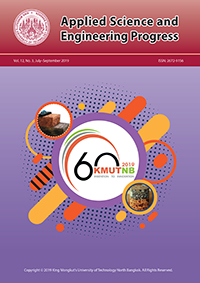Stress and Displacement Analysis of Dental Implant Threads Using Three-Dimensional Finite Element Analysis
Main Article Content
Abstract
Dental implant is one of the most common ways to replace a missing tooth. The objective of this research project is to analyze the compressive stress, shear stress, and displacement of prosthetic tooth. This research is conducted using a three-dimensional finite element method to analyze biomechanical characteristics on dental implant systems at four different areas: abutment, implant, cortical bone, and cancellous bone. This research focuses on a variety of patents of dental implant threads from the United States Patent and Trademark Office. Findings reveal a new conceptual design of dental implant thread model. It is found that the maximum stress concentration is found at cortical bone but is still lower than the yield strength of materials. The new design of dental implant tread provides the minimum compressive stress, shear stress, and displacement for dental implant systems.
Article Details
References
[2] C. Liang-jian, H. Hao, L. Yi-min, L. Ting, G. Xiao-ping, and W. Rui-fang, “Finite element analysis of stress at implant-bone interface of dental implants with different structures,” Transactions of Nonferrous Metals Society of China, vol. 21, pp. 1602–1610, 2011.
[3] L. Zheng, J. Yong, X. Hu, and J. Luo, “The dimensional finite element analysis of a novel osteointegrated dental implant designed to reduce stress peak of cortical bone,” Acta of Bioengineering and Biomechanics, vol. 16, no. 3, pp. 21–28, 2014.
[4] H. Zipprich, “Dental Implant System,” U.S. Patent 20140212844A1, Jul. 31, 2014.
[5] B.-W. Peng, “Dental Implant,” U.S. Patent 0140816800A1, July 3, 2014.
[6] T. Buurlage, “Dental Implant,” U.S. Patent 20140147808A1, May 29, 2014.
[7] C.-L. Lin, Y.-C. Kuo, and T.-S. Lin, “Effects of dental implant length and bone quality on biomechanical responses in bone around implants: A 3-D nonlinear finite element analysis,” Biomedical Engineering Applications Basis and Communications, vol. 17, no. 1, pp. 44–49, 2005.
[8] M. Mangalvedhekar and M. Herekar, “The influence of location of oeelusal loading on stresses transferred to implant-supported prostheses and supporting bone: A three dimensional finite element study,” Asian Journal of Midical and Clinical Sciences, vol. 3, pp. 63–67, 2014.
[9] L. Kong, Y. Zhao, K. Hu, D. Li, H. Zhou, Z. Wu, and B. Liu, “Selection of the implant thread pitch for optimal biomechanical properties: A threedimensional finite element analysis,” Advances in Engineering Software, vol. 40, pp. 474–478, 2009.
[10] L. Kong, Z. Gu, K. Hu, H. Zhou, Y. Liu, and B. Liu, “Optimization of the implant diameter and length in type B/2 bone for improved biomechanical properties: A three-dimensional finite element analysis,” Advances in Engineering Software, vol. 40, pp. 935–940, 2009.
[11] Y. Sun, L. Kong, K. Hu, C. Xie, H. Zhou, Y. Liu, and B. Liu, “Selection of the implant transgingival height for optimal biomechanical properties: A three-dimensional finite element analysis,” British Journal of Oral and Maxillofacial Surgery, vol. 47, pp. 393–398, 2009.
[12] J.-R. Xiao, Y.-F. Li, S.-M. Guan, L. Song, L.-X. Xu, and L. Kong, “The biomechanical analysis of simulating implants in function under osteoporotic jawbone by comparing cylindrical, apical tapered, neck tapered, and expandable type implants: A 3-dimensional finite element analysis,” Bitish Journal of Oral and Maxillofacial Surgery, vol. 69, pp. e273–e281, 2011.
[13] Y. Gao, Y.-F. Li, B. Shao, T. Li, N. Xia, L.-X. Xu, Z.-Y. Wang, and L. Kong, “Biomechanical optimisation of the length ratio of the two endosseous portions in distraction implants: A three-dimensional finite element analysis,” British Journal of Oral and Maxillofacial Surgery, vol. 50, pp. e86–e92, 2012.
[14] T. Li, X. Yang, D. Zhang, H. Zhou, J. Shao, Y. Ding, and L. Kong, “Analysis of the biomechanical feasibility of a wide implant in moderately atrophic maxillary sinus region with finite element method,” Oral Surgery, Oral Medicine, Oral Pathology, Oral Radiology, vol. 114, pp. e1–e8, 2012.
[15] M. Mangalvedhekar and M. Herekar, “The influence of location of occlusal loading on stresses transferred to implant-supported prostheses and supporting bone: A three dimensional finite element study,” Asian Journal of Medical and Clinical Sciences, vol. 3, no. 2, pp. 63–67, 2014.
[16] H. Abuhussein, G. P agin, A. Rebaudi, and H.-L. Wang, “The effect of thread pattern upon implant osseointegration,” Clinical Oral Implants Research, vol. 21, pp. 129–136, 2010.


